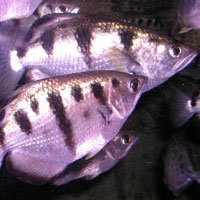Fishes - Archer Fish
 Region:
Southern Asia Region:
Southern Asia
Class: Osteichthyes
Order: Perciformes
Family: Toxotidae
Genus: Toxotes
Scientific Name: Toxotes jaculator
Description: Length: up to 15 cm. Large anal and dorsal
fins extend back almost to the caudal fin. The large mouth
points upward with an jaw that is distinctly adapted for
spitting jets of water.
Distribution: From India through southeast Asia, the Malay
Archipelago and parts of Australia to the Philippines.
Habitat: Mainly brackish waters of mangrove belts but
they may also live in the sea or go upstream into fresh
water.
Food: Their main food consists of small water animals
swimming or floating near the surface but when they are
hungry, archer's shoot down insects crawling on the leaves
and stems of overhanging vegetation.
Skin/Color/Coat: Silver with five broad vertical bars
on the sides.
Reproduction and Development: The adults apparently spawn
far from land in the regions of coral rock or coral reef.
The young return to the brackish water or even beyond
into the fresh water. They have the dark bars on the back,
as in the adults and they also have "light flecked,
yellow iridescent flecks on the back between the bars".
At times the flecks shine so brightly they appear as tiny
green fluorescent lights. It is suggested they may act
as recognition marks between members of the species, helping
them to keep together in the muddy waters. Archerfish
begin to spit when they are young and only a few centimetres
long, but the jets of water they produce do not travel
much over 10 cm . As they grow older their marksmanship
improves and the length to which they spit increases.
Adaptations: A fully grown adult is able to hit insects
180 cm away. Indeed, one fish has been seen to miss its
target and the jet of water travel measured 450 cm. If
it misses with the first jet, it will follow with several
more in rapid succession. At the moment of shooting the
tip of the snout is just breaking water, the eyes being
submerged. Water in the gill chamber is driven into the
mouth by a powerful compression of the gill covers. At
the same time, the tongue is pressed upwards, converting
a groove in the roof of the mouth into a tube which increases
the speed of outgoing streams.
Threats: Pollution and "development" of mangrove
areas reduce habitat available.
Status: Common
References: Encyclopedia of Animal Life. Part 3: 78-79.
Published by Marshall Cavendish Ltd., N.Y. |
|
|
